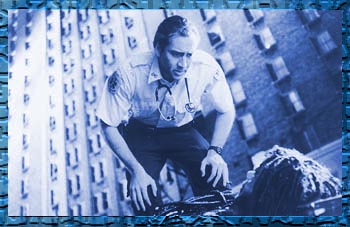![[MetroActive Movies]](/movies/gifs/movies468.gif)
[ Movies Index | Show Times | Santa Cruz Week | MetroActive Central | Archives ]
Photograph by Phil Caruso
How Are We Feeling Today? Nicolas Cage ministers to Marc Anthony on the streets of New York in 'Bringing Out the Dead.'
Ambulance Chasing
Martin Scorsese stiffs audience for ambulance drama 'Bringing Out the Dead'
By Richard von Busack
A FEW YEARS AGO, critic Joseph McBride did a series of interviews with director Howard Hawks, Hawks on Hawks. In the interviews, Hawks, one of the best American movie directors, explained a sort of law he had. When making a movie, he'd always try to turn it into a comedy first; he would only make the story serious if he couldn't figure out any way to make the story funny.
After his Tibetan excursion in Kundun, director Martin Scorsese is continuing to make gory rock operas. I wish that he had followed Hawks' scheme in Bringing Out the Dead, which works--when it works--as sick comedy.
In the apartment of our hero, Frank (Nicolas Cage), we see a copy of Celine's Journey to the End of the Night. There's a model for an ambulance film: the memoir by the King of Misanthropes, who was himself a doctor and who almost always managed to find the evil-comic side of disease and poverty. Almost instinctively, Cage fights against the script's urging toward Christian bathos--he's a naturally funny man and his disposition cuts against scriptwriter Paul Schrader's theological urges. Cage has played tons of manics but never depressive manics; this particular Taxi Driver reprise is the wrong material for him.
In interviews, Schrader has said that adapting Joe Connelly's novel was tricky. It's a guilt-haunted Irish Catholic story about working the ambulance night shift in the early '90s in Manhattan during the height of the crack epidemic. (Because of the tremendous urban rot and the soundtrack of punk-rock classics, such as Johnny Thunders' evocative "You Can't Put Your Arms Around a Memory," the early '80s seem a more appropriate time frame for the film; perhaps the '90s setting was a budgetary decision.)
The mood and the look resemble David Fincher's Fight Club, with New York as a gangrene-colored Insomniaopolis. The hospital looks like a Fincher construction, too: Our Lady of Perpetual Misery, they call it. In between trips there, Frank is dogged by hallucinations of a young girl he failed to save. He's unable to sleep during the days, working night shifts three in a row and seemingly unable to be fired, no matter how extreme his behavior or appearance. (Cage's Frank is dog-faced from lack of sleep, unshaven and with blood-shot eyes.)
In the midst of this hell shift--with a heat wave and full moon both, "the streets are gonna run with blood"--Frank undertakes a shy courtship with the emotionally injured daughter of one of his patients (played by Patricia Arquette, Cage's real-life spouse).
When Frank is at the point of breakdown, florid hallucinations start bedeviling him, such as an actual "white horse" striding around a huge encampment of junkies he drives up to visit. But the film, promising cataclysm, is more like the self-dramatized ravings of Hunter S. Thompson. Like Terry Gilliam's adaptation of Fear and Loathing in Las Vegas, Bringing Out the Dead can be admired for its style and morbid spirit, but the film still leaves you unaffected. It's as if you were watching a party through a window.
Bringing Out the Dead is an episodic, heavily narrated film, in which the same characters turn up again and again, except for the ones who matter. The patients are like the regulars on an emergency-room television show: particularly Marc Anthony as a homeless, deranged character who holds the key to Frank's salvation.
The underdeveloped characters of the three different men Frank works with on his shifts might have deepened the film. John Goodman brings some chuckles as the first. The second partner, Marcus, played by the splendid Ving Rhames, steals the film. Rhames' normally bald head is covered with a dapper wave of hair, and he has the sleek mustache and bull-moose baritone of a soul singer.
Marcus puts on a show, faith-healing an overdosed Goth with an appeal to God ("Lord, it's me again ...") while Frank surreptitiously gives the passed out kid an amphetamine shot. What an Elmer Gantry Rhames would make! When he disappears from the movie--to be replaced by Tom Sizemore as a garden-variety rage ball--the film loses heart and humor.
THERE ARE VISUAL pyrotechniques--such as the oblique camera angles that make the ambulances look as if they're sliding along the sides of the concrete canyons and a hallucination of the 4th of July off the top of a tower where Frank is performing a rescue. And yet the pacing is slow, for all the speedy images and occasionally smart episodes.
This is a two-hour film that runs like a two-and-a-half-hour film. Arquette, as miscast as Cage, doesn't do wariness well, and she seems like another hallucinatory zombie; there's never a glitter of promise underneath her crusty shell as Frank tries to court her.
The one trauma that sets Frank off, the death of Rose (Cynthia Roman), looks peaceful; it takes place on the sidewalk of a quiet, snowy street, and Roman's character dies relatively easily--why would this particular ghost haunt him? We never know why. Too many of the mysteries in the film aren't bypassed with velocity--or better still, with a good horrified laugh.
Copyright © Metro Publishing Inc. Maintained by Boulevards New Media.
![]()

Bringing Out the Dead (R; 122 min.), directed by Martin Scorsese, written by Paul Schrader, based on the novel by Joe Connelly and starring Nicolas Cage, Patricia Arquette and Ving Rhames, plays at selected theaters.
From the October 27-November 3, 1999 issue of Metro Santa Cruz.